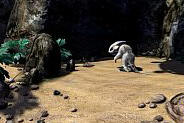Exile, the third game in the “Myst” series, returns the player once again
to the D’ni universe and the house of Atrus. Atrus has perfected the D’ni
art of creating “linking books” – documents in which potent words create
doorways to alien worlds. This game, like the original “Myst”, foregoes
extensive character interaction and instead sweeps the player into
brilliantly detailed environments that challenge the mind and engulf the
senses.
Exile focuses on the plight of Saavedro, who is plotting revenge against
Atrus and his family. Saavedro has been forced to live alone in a series
of “Ages” or worlds created years before by Atrus to teach conceptual and
moral lessons to his sons. Each world has been subtly altered, and now
contains messages from Saavedro. These video messages are terse but
unexpectedly moving. Each one attempts to make you understand, not just
the story of what has transpired, but the emotions that events have
engendered. The messages gradually reveal Saavedro’s motivation and hint
at a long-awaited game-ending confrontation.
The first gameworld, J’nanin, is a hub world introducing the player to the
game while also providing transport to other places. J’nanin is a
traditional "Myst" Age with cliffs and rippling waterscapes and close-ups
of interesting rock surfaces. The sun glares as you look at it -- quite a
realistic effect. The water effects are more realistic in the foreground
than they are near the horizon.
The puzzles in this Age hint at the variety of puzzles and environments
that you will later encounter in the Voltaic, Edanna and Amateria Ages. I
thought this was a clever way to whet the appetite for what is soon to
follow.
The background music is clearly inspired by the music in “Riven”. J'nanin
is not only a lesson Age and a portal Age, it is also a place of
transition. It recalls the worlds of “Myst” and “Riven,”, but prepares the
player to be pulled away in new and unexpected directions.
Here, in a surprisingly obvious spot, you discover Saavedro's' journal.
Why is he so kind as to leave his enemy such helpful information? Is he
trying to lure you into a trap?
My favorite world in Exile is definitely NOT a traditional “Myst” Age.
Edanna is confounding and confusing. Down you twist through a tangle of
branches, leafy tendrils and thorny vines. The sense of otherworldly
mystery deepens as you descend. It's like being in the middle of a
demented Rodin sculpture with sinewy interlocking limbs everywhere.
Sunlight filters through the dense foliage in places, and other, stranger
sources provide pinpoints of colored light.
Deeper and deeper, layer after layer of visual detail, so much that the
eye almost rebels and refuses to take it all in. There are no mazes in
this game, but Edanna comes very close to feeling like a maze. You look
for something to mark the path to find your way back, but the profusion of
forms makes that almost impossible. In the heart of the tree the layers of
leaves in the dusky light have a rich tapestry texture, and the striations
and strokes of color in the wooded and flowering forms have run riot.
Exile’s puzzles are challenging, but they are fair. There are no sliding
tile puzzles. You’ll encounter mechanical puzzles, interpretive enigmas
and sequencing challenges. I think that the puzzles in Edanna are
especially logical, assuming you can orient yourself sufficiently in order
to be able to think. The ice ball puzzles in the Amateria Age are
particularly fun – and the ride at the end of Amateria is the most
unexpected yet logically satisfying puzzle reward in the “Myst” series.
There are many endings to Exile. These depend on your choices in the final
world of Narayan. It's great fun exploring these endings, observing how
the characters of Saavedro and Atrus are revealed, and seeing how various
ends are tied up -- or not.
The acting in Exile is, for the most part, pretty good. However, there is
one scene in Narayan that clearly goes over the top – though you could
easily fault the writing as well as the acting for this excess. The game
contains a few other minor disappointments….
It takes some time to get used to the cursor. You don't hold down the left
mouse button for panning. This means picking up the mouse up to reorient
the cursor. You can hold down the right mouse button and pan that way,
then click with the left to move forward. This takes some practice, but
does give the player more control.
The music in Exile is lovely, and effort was clearly made to create a
sound track of extraordinary quality. Still, in certain places I missed
the eerie, spooky, occasionally odd music that mixed so well with the
visual wonders of “Myst” and “Riven”.
The game played perfectly until the ending credits, where it crashed to
the desktop.
My final complaint -- the Saavedro story should have been expanded. There
are more details about the relationship between Saavedro and Atrus in the
official strategy guide – these should have been included in the game.
On the whole, Exile has lived up to my expectations. Since my expectations
for a “Myst” game are astronomically high, meeting them is quite an
accomplishment.
Final Grade: A+
copyright © 2004
GameBoomers
